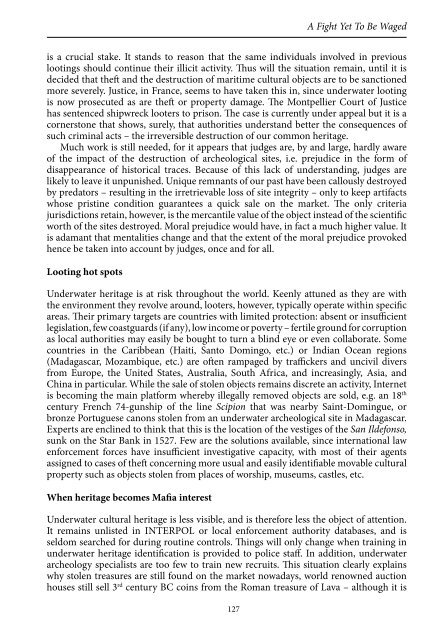Countering
Book_observatory_illicit_traffic_version%20issuu
Book_observatory_illicit_traffic_version%20issuu
You also want an ePaper? Increase the reach of your titles
YUMPU automatically turns print PDFs into web optimized ePapers that Google loves.
Michel L’Hour<br />
listed as ‘national treasure’ in France – and looters have been apprehended and sentenced.<br />
The fight against the circulation of stolen heritage and laundering of considerable sums<br />
is thus justified in many ways. Let us bear in mind that a Roman Imperial coin – be it,<br />
for instance, an aureus struck under Emperors Gallienus (253-268 B.C) or Claudius II<br />
Gothicus (268-270) – is worth some €600,000 to €800,000 per piece. That same coin,<br />
sold in Singapour or Costa Rica after having been bought in Paris and transported in a<br />
simple unverified wallet, can enable de facto near €1,000,000 to be laundered. A more<br />
systematic control of numismatists and leading antique coin dealers is thus advisable,<br />
if only to reinforce the fight against money laundering. Hence, for each piece of coin<br />
sold, dealers and auction houses should systematically be made to provide specific<br />
data: provenance, name of the inventor, or previous holder identity and residence, and<br />
method of payment, etc.<br />
A fight yet to be won<br />
In this article, I have described the many circumstances that explain the difficulties<br />
met by underwater heritage specialists today: the indifference or forgetfulness of law<br />
enforcement authorities, which stems from disinformation and insufficient training<br />
in heritage protection, except in a few countries such as Canada, China, and France<br />
(among others), who all have dedicated forces (e.g. in France, teams of underwater<br />
archaeologists and custom officers). Fostering global awareness on the stakes at hand<br />
for the preservation and protection of underwater heritage is more than ever critical.<br />
The ratification by a growing number of countries of the 2001 UNESCO Convention on<br />
the Protection of Underwater Cultural Heritage is one first, fruitful step. In the face of<br />
urgency, progress is slow. Since looting knows no boundary, investigators, archeologists<br />
and curators must, likewise, work together on a global scale. Time is short, and<br />
underwater heritage vanishing. It is our responsibility to protect it.<br />
Note<br />
All original data comes from the author’s findings and field experience. Some relevant<br />
sources have been necessarily anonymized.<br />
128


